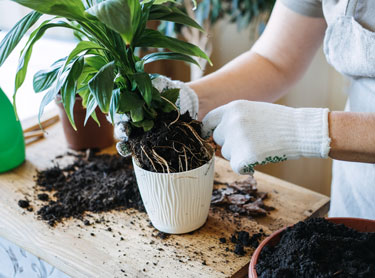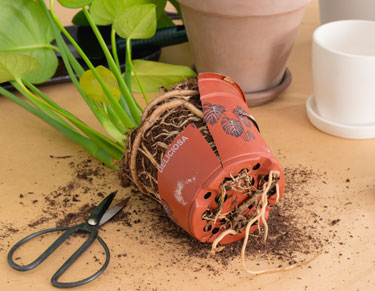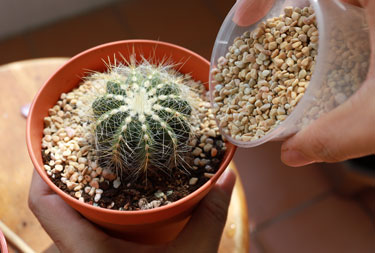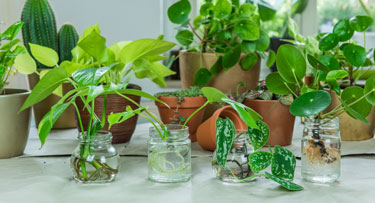A new lease on life!
Plant revival
It can be tempting to give up on a lacklustre houseplant, but it’s amazing how quickly a potted plant, indoors or out, can recover its youthful good looks once repotted into fresh potting mix. Freeing up the roots and supplying them with fresh growing media allows the plant to access the water it needs for a brand new flush of lush healthy growth.
Plants are actively growing at this time of year, spreading their roots in search of nutrients, so it’s a good time to give them some more space to grow. Choose a good quality potting mix to suit your particular plant then repot into the next sized pot (about 5cm more in diameter than the plant’s previous pot). Drainage holes are essential.
If you don’t want your plant to grow larger, most can be root trimmed and returned to the same pot with fresh potting mix, using clean sharp scissors to trim the roots. Remove dead or damaged roots first, then up to half the root volume from the bottom and sides of the rootball. Alternatively, houseplants that grow in clumps can be divided into two or three smaller ones. Some produce ‘pups’ which can be removed and reported as baby houseplants.
After repotting add a decorative pebble mulch to help conserve moisture, or try Yates Gnat Barrier pumice granules to deter these pesky potting mix dwellers.
Instant update
Whether you make your own or choose from the expansive range of affordable cover pots on offer in garden centres, a trendy new vessel brings style and glamour to the most humdrum of houseplants. Be sure to choose a cover pot that is the right fit for your plant. A quick flick of a tape measure can circumvent the disappointment of coming home with a cover pot that’s too narrow or too short. Indoor plants also look great in baskets or fabric bags made from felted wool, thick hessian or heavy canvas - even up-cycled jeans. Place a saucer inside to catch the drips.
TIP: To avoid overwatering, take plants out of their decorative pot for watering, replacing them once the excess water has drained away.
From pot to garden
Instead of repotting, you might choose to revitalise a plant thats outgrown its pot simply by transplanting it into the garden, where it will have free access to soil water and nutrients. Of course this depends on the soil and climate being suitable. Take care also when moving plants from shade to sun. Even if it is a plant that normally tolerates bright light, it may be vulnerable to sunburn if it has been living its former life undercover. Move it gradually into brighter light while still in its pot.
From garden to pot
On the other hand, some plants may perform better in a pot than they have in the garden soil, especially plants that need perfect drainage or warmer temperatures. You can create container plants from what you already have growing in the garden. Great as gifts, succulents make bullet proof container plants and grow very easily from divisions or pups found in the garden.
Also, cuttings made after trimming a hedge or shrub can become little topiaries in pots (e.g. lavender, rosemary, or English box). Flowering perennials that grow easily from cuttings and make excellent container plants for outdoors include perlagnium (aka geranium), daisies, fuchsias and hydrangeas.
Pot revival
Before replanting into old used pots, give them a thorough clean to remove any pests and diseases that are lurking. Once they’re clean and dry, you might want to give them a new look with a lick of paint. It could be a good chance to use up left over paint from another project.
Divide and multiply
Some plants, including many indoor plants, grow as clumps. This makes it easy to propagate new plants by carefully dividing the clumps and re-planting into fresh potting mix. This is also an important way to give plants a new lease of life when they out grow their pots. When pot plant roots grow into a tightly congested mass they’re unable to efficiently absorb the water and nutrients they need to remain healthy.
To divide an indoor plant first remove the plant from its pot. Using a clean sharp knife, carefully cut the clump into two or three sections retaining roots, stems and leaves on each section. Division is ideally done in the warmer months when plants are actively growing.
Some plants, including many succulents, produce ‘pups’ (baby plants) around the ‘mother’ plant. The pups can be removed and replanted in their own pot. Often they will have formed roots of their own, or they may grow them after you plant them in well drained potting mix.
For houseplants that don’t grow as clumps, many will grow easily from stem cutting or root cuttings which can be a good way to start a new plant before you throw away a plant that has grown old and unattractive. For some plants it may simply be a case of cutting it plant right back, and repotting and waiting for fresh growth to appear. Many ferns can be revived this way.
TIPS:
- Don’t fill pots right up to the rim, allow a gap of about 2cm below the rim for water to pool.
- Water minimally to help settle the potting mix and then refrain from watering for a few weeks to give time for roots to heal.
- Water the plant thoroughly a day or two before repotting.
- For very root bound plants, sliding a knife around the perimeter to loosen the roots will help.

1-Dec-2021

Use only the best quality potting mix for repotting indoor plants.

When roots have extended beyound the pot, they can be trimmed off carefully and cleanly before repotting into a new pot and fresh potting mix.

A layer of pebbles makes a decorative finish for any potted plant.

Many houseplants will grow easily from cuttings - new roots will grow in water before they can be potted up.

